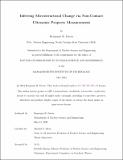| dc.contributor.advisor | Short, Michael P. | |
| dc.contributor.author | Dacus, Benjamin R. | |
| dc.date.accessioned | 2024-07-10T20:22:26Z | |
| dc.date.available | 2024-07-10T20:22:26Z | |
| dc.date.issued | 2024-05 | |
| dc.date.submitted | 2024-06-13T16:26:30.945Z | |
| dc.identifier.uri | https://hdl.handle.net/1721.1/155657 | |
| dc.description.abstract | Reactor pressure vessels (RPVs) are irreplaceable components in nuclear reactors that need to be consistently evaluated to ensure the safety of operation. With the push to extend reactor lifetimes in the US to 80 years in order to meet low-carbon energy demands, these RPVs need to be evaluated with non-destructive methods due to the limited number of representative RPV coupons that exist for material evaluation via destructive tests. Transient Grating Spectroscopy (TGS) has been proposed as a non-destructive technique that can evaluate material evolution in reactor systems, but its applicability as an inference model has yet to be demonstrated on RPVs or similar systems. In this thesis, TGS is used to develop an inference model for microstructural evolution in precipitation-hardening alloys in order to understand the applicability of TGS as a non-destructive measure-of-health technique to investigate RPVs in commercial nuclear reactors. This is accomplished by showing the effects of solute clustering, precipitation, and grain growth due to thermal aging and irradiation in binary Cu-3at%Ti, where a clear relationship exists between thermal diffusivity, surface acoustic wave (SAW) frequency and microstructure. A model RPV alloy, which experiences embrittlement via the same mechanisms as commercial RPV alloys, is investigated with TGS and atom probe tomography (APT) to show how commercial alloy precipitation affects the evolution of thermal diffusivity measured by TGS after thermal aging and irradiation. The results show, in a different trend seen in the Cu3Ti alloy, an initial decrease in the thermal diffusivity due to nanoscale precipitation effectively scattering lattice phonons, followed by a continuous increase in thermal diffusivity after thermal aging. A theoretical model for thermal conductivity is developed using the observed microstructural features as a function of thermal aging time and the predictions match closely with the experimental results. Finally, APT and initial TGS analyses of commercial RPVs show that while promise exists for using TGS to infer RPV health, additional measurements are necessary to reach the required sensitivity. The development of inference models for understanding microstructure evolution in precipitation-hardening alloys via properties measured with TGS show the potential of TGS to be used in the future as a non-destructive method of evaluation of RPV health. | |
| dc.publisher | Massachusetts Institute of Technology | |
| dc.rights | Attribution-NonCommercial-NoDerivatives 4.0 International (CC BY-NC-ND 4.0) | |
| dc.rights | Copyright retained by author(s) | |
| dc.rights.uri | https://creativecommons.org/licenses/by-nc-nd/4.0/ | |
| dc.title | Inferring Microstructural Change via Non-Contact Ultrasonic Property Measurements | |
| dc.type | Thesis | |
| dc.description.degree | Ph.D. | |
| dc.contributor.department | Massachusetts Institute of Technology. Department of Nuclear Science and Engineering | |
| mit.thesis.degree | Doctoral | |
| thesis.degree.name | Doctor of Philosophy | |
